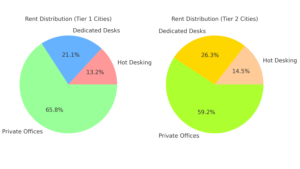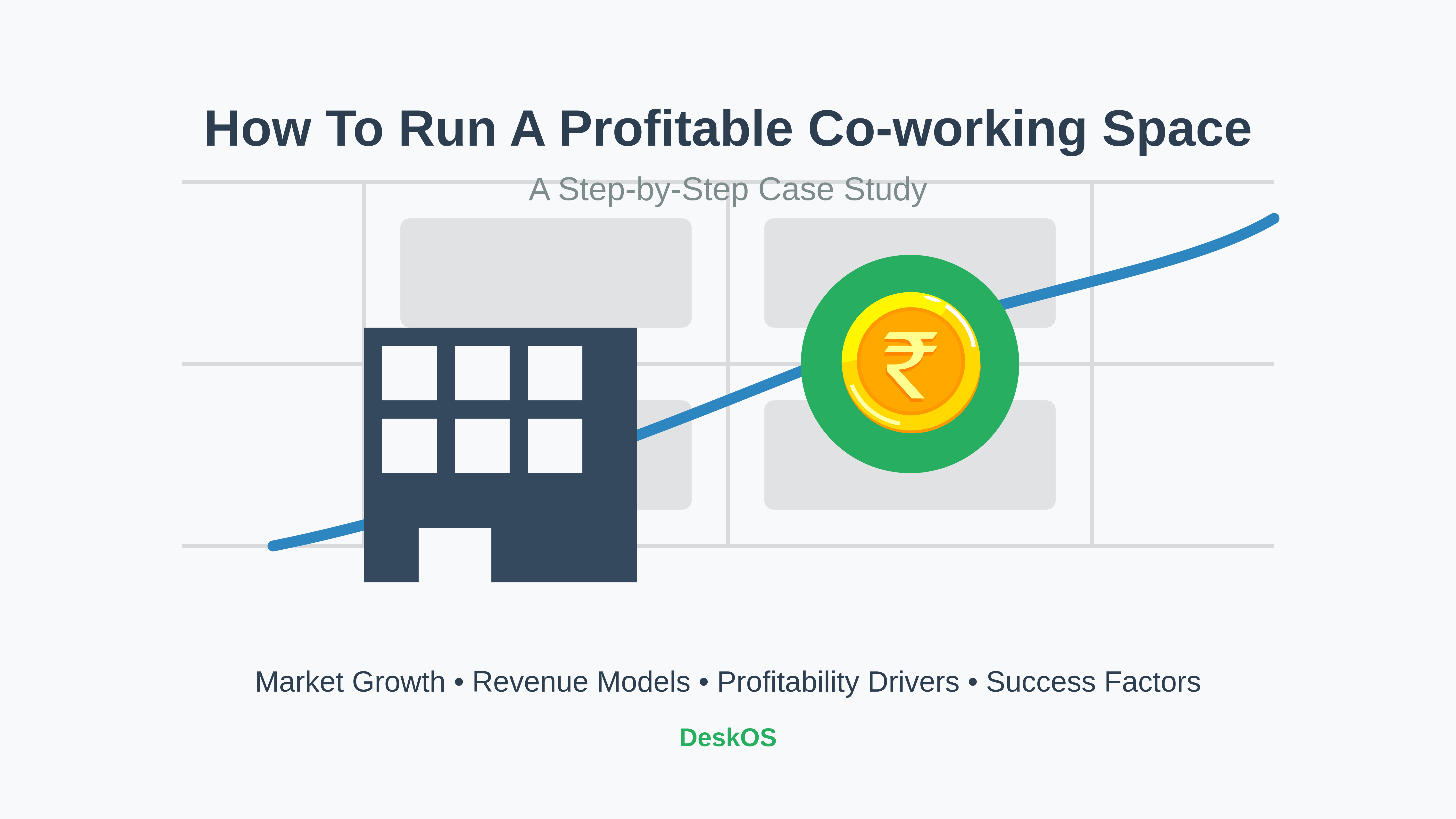Coworking spaces have rapidly become a crucial part of India’s business landscape, particularly in urban centers where work dynamics are constantly evolving. The question on many entrepreneurs’ and investors’ minds is: How profitable are coworking spaces in India? This in-depth analysis aims to answer this by looking at the market’s current state, revenue models, profitability drivers, key success factors, and future trends.
1. The State of Coworking Spaces in India: A Growing Market
The Indian coworking space market has undergone a significant transformation in recent years, driven by the rise of flexible work environments, increased demand from startups and freelancers, and evolving office culture due to the hybrid work model. India’s market for coworking spaces is projected to grow rapidly in the coming years, driven by both corporate and individual demand for affordable, flexible office spaces.
Market Size and Projections
India’s coworking space market is on an upward trajectory. As of 2023, the market size stands at around $1.5 billion, and experts project it will reach $3.35 billion by 2027. The number of coworking spaces is also expected to increase from 800+ in 2023 to 1,500+ by 2027.
Source: Industry reports, 2023

Source: Industry reports, 2023
This data clearly indicates that coworking spaces in India are positioned for strong growth, particularly as businesses move toward more flexible models and India’s startup ecosystem continues to expand.
2. Key Drivers of Profitability in Coworking Spaces
Understanding the key drivers of profitability in the coworking space industry is essential for owners and potential operators. Let’s break down the primary factors contributing to profitability:
A. The Rise of Hybrid and Remote Work
The hybrid work model is here to stay. According to a report by PwC India, more than 35% of companies in India have adopted hybrid work policies, with 60% of employees working from home at least once a week. This trend presents a significant opportunity for coworking spaces, which can offer businesses and remote workers the flexibility of workspaces without the commitment of long-term office leases.
Hybrid Work Adoption in India: By 2025, it’s estimated that 50% of India’s top 100 companies will have at least 30% of their workforce working from coworking spaces.
This shift is expected to result in a 20-25% increase in demand for coworking spaces in India over the next 5 years.
B. The Growth of India’s Startup Ecosystem
India has one of the world’s largest and fastest-growing startup ecosystems, with over 75,000 startups and many more being added annually. Startups are particularly drawn to coworking spaces because they offer a cost-effective and flexible solution compared to traditional office spaces. With low overhead costs, access to high-end facilities, and the ability to scale up or down as needed, coworking spaces are a natural choice for many early-stage companies.
| Number of Startups in India (2015-2022) | 2015 | 2017 | 2020 | 2022 |
|---|---|---|---|---|
| Total Startups | 4,200 | 8,500 | 50,000 | 75,000+ |
| Annual Growth Rate | – | 102% | 500% | 50%+ |
Source: Startup India, 2022
With more startups and entrepreneurs emerging, there is a growing demand for flexible office spaces. Coworking spaces cater to this segment by providing the perfect environment for innovation and collaboration.
C. The Rise of Freelancers and the Gig Economy
India is home to a thriving freelancer and gig economy, with more than 15 million freelancers in various sectors, such as IT, media, marketing, and design. Many freelancers prefer coworking spaces because of the flexibility, networking opportunities, and cost-effectiveness they offer compared to traditional offices.
- Freelancer Growth: By 2025, it is estimated that 25% of India’s workforce will be part of the gig economy, driving significant demand for coworking spaces.
The increasing preference for coworking spaces among freelancers and independent contractors further enhances the profitability of the coworking space market.
3. Revenue Models of Coworking Spaces
Coworking spaces typically generate revenue from various streams. Understanding these revenue models is crucial for operators who want to ensure their business is profitable.
A. Membership Fees: The Primary Revenue Source
Membership fees are the core revenue stream for most coworking spaces. Memberships vary depending on the level of access and the type of space selected. Here’s a breakdown of typical membership rates in India:
This table shows the average costs of coworking memberships across different types of setups and cities. Tier 1 cities like Bangalore, Mumbai, and Delhi command higher rent prices compared to Tier 2 and Tier 3 cities.
B. Add-Ons and Premium Services
Aside from membership fees, coworking spaces also generate significant revenue from add-on services, including meeting rooms, event space rentals, and IT support. These services often have high-profit margins due to their short-term nature and the premium services offered.
| Add-On Service | Revenue per Month | Revenue per Event |
|---|---|---|
| Meeting Rooms | ₹40,000 – ₹1,00,000 | ₹500 – ₹2,000 per hour |
| Event Space Rentals | ₹75,000 – ₹3,00,000 | ₹1,00,000 – ₹5,00,000 |
| Premium Services | ₹3,000 – ₹10,000 per user | N/A |
These additional services not only boost revenue but also help attract corporate clients who need professional facilities for meetings, workshops, and team-building events.
4. Coworking Space Profitability: A Case Study
Let’s consider a coworking space located in Bangalore, one of India’s highest-demand cities for coworking. Below, we’ll calculate the potential revenue and operating costs for a typical coworking space.
Revenue Breakdown

Total Monthly Revenue: ₹33,00,000 + ₹62,500 + ₹2,50,000 + ₹6,00,000 = ₹41,12,500
Operating Costs Breakdown
| Cost Component | Monthly Cost (₹) |
|---|---|
| Rent | ₹15,00,000 |
| Salaries (Staff) | ₹4,50,000 |
| Utilities | ₹2,50,000 |
| Marketing | ₹1,50,000 |
Total Monthly Operating Costs: ₹23,50,000
Net Monthly Profit:
Net Profit = ₹41,12,500 – ₹23,50,000 = ₹17,62,500
This case study shows that coworking spaces can achieve a profit margin of 40% or more, depending on the location, services offered, and occupancy rates.
5. Factors that Influence the Profitability of Coworking Spaces in India
While the potential for profit in the coworking space industry is immense, various factors can determine the actual profitability. Here’s a detailed look at these factors:
A. Location:
- Urban vs. Semi-Urban: Cities like Bangalore, Delhi, Mumbai, and Hyderabad dominate the coworking space market due to their large population of professionals, startups, and freelancers. However, semi-urban locations are gaining traction with the rise of remote working. For example, tier-2 cities such as Jaipur, Lucknow, and Chandigarh are seeing increased demand for coworking spaces.
- Proximity to Key Areas: Spaces located near business districts, tech parks, or educational institutions attract more clients due to easy accessibility and the presence of target markets.
B. Target Market:
- Startups and SMEs: The startup ecosystem in India has been flourishing, and coworking spaces offer flexibility, cost-efficiency, and scalability. According to a report by KPMG, India ranks as one of the largest hubs for startups globally, contributing significantly to coworking space growth.
- Freelancers and Remote Workers: As remote work becomes the norm, coworking spaces are attracting individuals who require professional environments, networking opportunities, and flexibility.
C. Pricing Strategy:
- Affordable Membership Tiers: Offering tiered pricing allows coworking spaces to cater to different market segments—from individuals to small teams and large enterprises. Pricing varies significantly depending on the type of space (dedicated desk, hot desk, private office), the location, and the services included.
- Flexible Contracts: Flexibility in contracts—monthly or quarterly options—attracts more customers compared to long-term leases. This also ensures steady cash flow for coworking space owners.
D. Operational Efficiency:
- Staffing and Management: Efficient management can reduce operational costs. Coworking spaces should hire minimal staff while focusing on customer service, maintaining cleanliness, and providing support for clients’ needs.
- Technological Integration: The use of apps, booking systems, and automation for billing, space management, and customer support can enhance operational efficiency and improve the customer experience.
E. Community and Networking Opportunities:
- Community Building: Coworking spaces thrive on the sense of community they create. Hosting events, meetups, and networking opportunities increases customer retention. A robust community can help businesses grow, attract new clients, and drive word-of-mouth marketing.
- Collaboration and Partnerships: Encouraging collaboration between members—whether through shared projects, partnerships, or mentorship opportunities—adds value and keeps clients engaged.
F. Future Trends and Opportunities in Coworking Spaces (2025-2030)
As the coworking industry continues to evolve, there are several key trends that will influence profitability in the coming years:
a. Expanding to Tier 2 & 3 Cities
Coworking spaces in Tier 2 and Tier 3 cities are expected to see rapid growth. Cities like Pune, Ahmedabad, Jaipur, and Chandigarh are projected to grow at an annual rate of 20-25% from 2025 onward. This presents an incredible opportunity for coworking space owners to expand their operations into these underserved markets.
| Growth Rate of Coworking Spaces in Tier 2 Cities | 2023 | 2025 Forecast | 2030 Forecast |
|---|---|---|---|
| Annual Growth Rate | 10-15% | 20-25% | 30%+ |
b. Incorporating Technology and Automation
To remain competitive, coworking spaces will increasingly adopt technology-driven solutions such as AI-powered booking systems, virtual offices, and automated administrative processes. This shift will help reduce operational costs and increase efficiency.
c. Green Coworking Spaces
As sustainability becomes a core value for businesses, eco-friendly coworking spaces—that prioritize energy efficiency, green designs, and sustainable materials—will attract a premium market segment.
Conclusion
Coworking spaces in India represent a lucrative business opportunity, driven by trends in flexible working, the growing startup ecosystem, and the increasing number of freelancers. With the right location, service offerings, and management, coworking space owners can expect healthy profit margins and sustained growth. By capitalizing on the growing demand for flexible office spaces and diversifying their revenue streams, coworking spaces in India are poised to remain a profitable venture in the coming decade.





